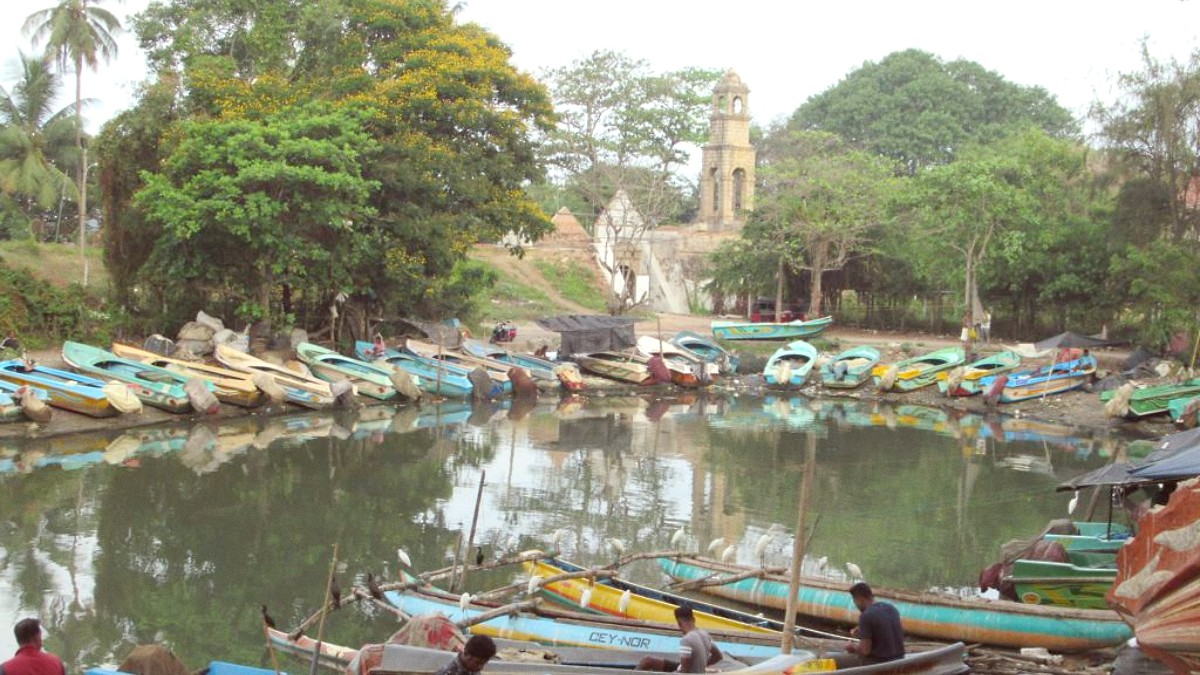
West Coast, Sri Lanka
Sri Lankan cuisine absorbed influences from various cultures over centuries. Portuguese, Dutch, British, Indian, and Middle Eastern traders and colonizers all left their mark, resulting in an unique fusion of flavors.
Cuisine relies heavily on rice as a staple, combined with abundant coconut milk, a wide array of aromatic spices, and fresh, locally sourced ingredients.
Traditionally, Sri Lankans eat rice and curry with their right hand. Mix a small portion of rice with curry and sambol, forming a ball. Many restaurants for tourists have cutlery, but trying the traditional way is an experience. Always use your right hand.
Dishes are often ordered and shared among groups, especially various curries served with a central rice portion.
Sri Lankans are generally hospitable and proud of their food. Accepting offers of food or tea shows respect.
This is the national dish and a staple. It consists of a mound of steamed rice served with an assortment of 3-5 different curries. These typically include a dhal (lentil) curry, several vegetable curries (pumpkin, potato, green bean, jackfruit), and often a fish, chicken, or beef curry, alongside a spicy sambol.
Widely available throughout Negombo.
These unique, bowl-shaped pancakes are made from fermented rice flour and coconut milk. They are crispy around the edges and soft and spongy in the middle. You can have plain hoppers, egg hoppers (with an egg cooked into the center), or sweet versions with jaggery.
Common for breakfast or dinner.
A popular street food, Kottu Roti is a lively dish. Shredded flatbread (roti) is stir-fried on a hot griddle with finely chopped vegetables, eggs, and your choice of meat (chicken, beef, or fish), all mixed with aromatic spices. The rhythmic chopping sounds of the spatulas on the griddle are iconic.
A popular street food.
Tea: Sri Lanka is globally famous for Ceylon Tea. You will find tea served everywhere. King Coconut Water: Refreshing, hydrating, consumed directly from the orange king coconut, readily available from roadside vendors. Fresh Fruit Juices: Enjoy fresh juices made from local tropical fruits like mango, pineapple, papaya, and passion fruit. Arrack: A traditional alcoholic spirit distilled from the fermented sap of the coconut flower. It can be consumed neat, with soda, or mixed into cocktails. Lion Lager: The most popular local beer, widely available.
Curd and Treacle: A simple yet delicious dessert. Thick buffalo curd, similar to yogurt, served with Kithul treacle, a sweet syrup from the Kithul palm tree. Kavum: Traditional oil cakes from rice flour and treacle, often prepared during festivals.
Some luxury hotels feature upscale dining establishments. These often offer international cuisine, Sri Lankan fusion dishes, and a refined dining ambiance.
Numerous mid-range options, specifically along the beach strip (Lewis Place, Porutota Road). These offer a mix of Sri Lankan, Indian, Chinese, and Western dishes, with a strong emphasis on fresh seafood.
Local rice & curry shops throughout Negombo town provide generous, inexpensive portions of authentic food. Look for places busy with locals. The Fish Market area has nearby stalls with freshly prepared seafood. Street food stalls appear evenings with Kottu, roti, and fried snacks.
Beyond Sri Lankan food, discover restaurants serving Indian, Chinese, Italian, and general Western cuisine, specifically in tourist zones.
Variety beyond local tastes.
Negombo Fish Market: mainly for raw fish, the surrounding area has vendors selling local produce and small, casual eateries for freshly cooked seafood. Local Markets: Explore for fruits, vegetables, and local snacks.
Experience local commerce.
Sri Lankan cuisine is very vegetarian-friendly. Many curries are plant-based. Ask for "vegetarian rice and curry".
Halal is widely available due to a Muslim population; look for signs. Kosher options are very limited; consider vegetarian/vegan or self-catering.
Rice and curry, hoppers, and string hoppers are naturally gluten-free. Roti and Kottu contain wheat. Clearly communicate dietary needs.
Always communicate specific allergies (nuts, dairy, shellfish) to staff. A translated note for clarity is helpful.
While not directly in Negombo, day trips inland feature spice gardens, where you learn about cultivation and uses. Tea plantations, further in the hill country, also offer insights.
Explore agricultural roots.
Negombo lacks major annual food festivals. During local celebrations like Sinhala and Tamil New Year (April), special traditional sweet meats and dishes are available in markets.
Seasonal culinary delights.
Many beachfront restaurants permit you to select your fresh catch of the day (often displayed on ice) and have it grilled to your preference.
Some restaurants or guesthouses located along Negombo Lagoon offer dining with picturesque views, especially at sunset, providing a tranquil backdrop to your meal.
Some guesthouses or local operators in Negombo offer hands-on Sri Lankan cooking experiences. You learn to prepare traditional curries and staple dishes.
While not directly in Negombo, day trips inland feature spice gardens, where you learn about cultivation and uses of various spices.
Negombo does not host major annual food festivals specifically. During local celebrations like Sinhala and Tamil New Year (April), special traditional sweet meats and dishes are prepared.
Halal options are widely available due to a significant Muslim population; look for "Halal" signs. Kosher options are very limited.
Consider vegetarian/vegan or self-catering for Kosher.
Each full moon day (Poya) is a public holiday and a Buddhist religious observance. Alcohol sales are restricted on these days, and many businesses may close early.
Plan accordingly for these days.
Do not hesitate to try this popular street food. It is a lively dish with rhythmic chopping sounds from spatulas on the griddle.
Seek stalls with a high turnover of customers. This usually indicates freshness and popularity, leading to a better experience.
Patties, rolls, sambol vada, and samosas are widely available at street stalls. A quick and flavorful way to experience local tastes.
Do not hesitate to try street food, notably Kottu Roti. It is a and flavorful experience.